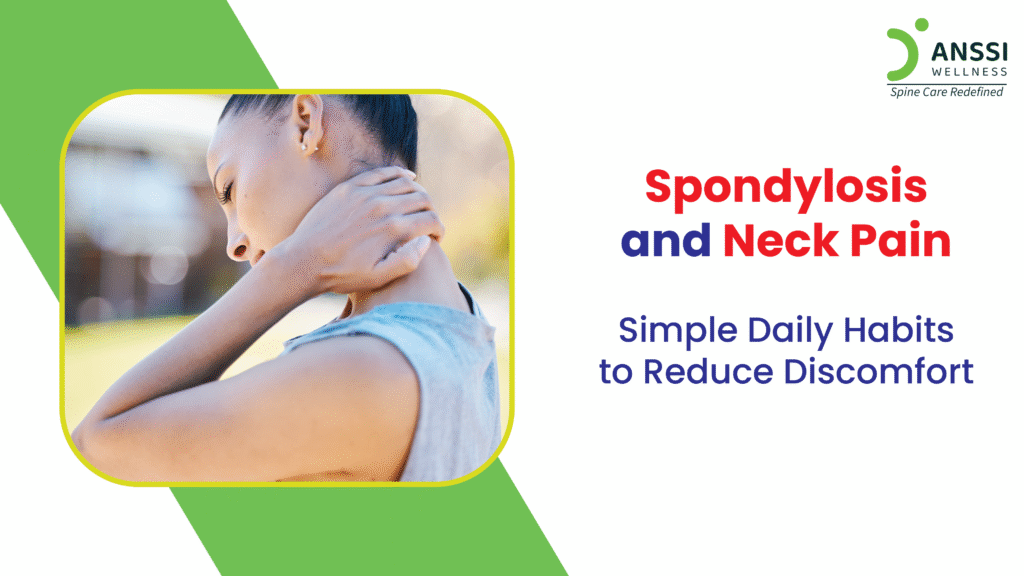Neck pain is a common issue in today’s fast-paced, desk-bound lifestyle. One of the major contributors to chronic neck pain is cervical spondylosis, a condition caused by the natural wear and tear of the cervical spine.
While age-related degeneration is unavoidable, the good news is that simple changes in your daily habits can significantly reduce discomfort and prevent further complications.
Understanding the condition and making mindful lifestyle adjustments is key to managing spondylosis without invasive treatments.
What is Cervical Spondylosis?
Cervical spondylosis is a degenerative condition that affects the discs, bones, and joints in the neck. As we age, the discs in the cervical spine begin to lose hydration and elasticity, causing them to shrink or bulge. The vertebrae may also develop bone spurs, and the spinal canal can narrow, putting pressure on nearby nerves.
This often leads to symptoms such as:
- Chronic neck pain or stiffness
- Pain radiating to the shoulders or arms
- Numbness or tingling in the hands
- Muscle weakness
- Limited range of motion in the neck
While spondylosis is common in older adults, modern sedentary lifestyles have caused the condition to appear earlier in working professionals, especially those who spend long hours in front of screens.
How Daily Habits Impact Neck Health
The way we sit, move, sleep, and work every day has a direct impact on spinal health. Poor posture, lack of movement, and incorrect ergonomics can all exacerbate the symptoms of spondylosis. However, incorporating healthy, consistent habits into your routine can reduce stress on the neck, relieve pain, and prevent the condition from worsening.
Simple Daily Habits to Reduce Discomfort
1. Maintain Good Posture
Maintaining the right posture throughout the day is crucial for neck health. Most people unknowingly adopt a forward head position while sitting, which puts extra strain on the cervical spine.
Follow these posture tips:
- Don’t lean forward; instead, keep your head in line with your spine.
- Sit with your shoulders relaxed and your back straight.
- Avoid cradling your phone between your neck and shoulder.
- Use lumbar and neck support when sitting for long periods.
2. Create an Ergonomic Workstation
If you work at a desk, make sure your workstation supports your posture:
- Make sure your screen is at eye level so you don’t have to glance down.
- Make use of a chair that supports your neck and lumbar area well.
- Maintain a 90-degree angle at your knees and flat feet on the ground.
- Every 30 to 60 minutes, take some time to exercise and stretch.
3. Incorporate Neck-Friendly Stretches
Gentle, consistent stretching can help relieve muscle tightness and improve mobility.
Try these simple stretches:
- Neck Tilts: Slowly tilt the head toward your shoulders on each side.
- Chin Tucks: Pull your chin gently toward your chest, aligning your neck.
- Shoulder Rolls: Roll your shoulders backwards and forward to release tension.
- Neck Rotations: Turn your head side to side slowly and gently.
Always perform these stretches slowly, and avoid pushing through pain.
4. Use the Right Pillow and Sleeping Position
The way you sleep has a significant impact on your neck. Poor sleeping posture can aggravate spondylosis symptoms.
Follow these tips:
- Use a medium-firm pillow that keeps your neck aligned with your spine.
- Sleeping on your stomach puts tension on your neck, so avoid doing so.
- In general, sleeping on your side or back supports your neck better.
- A cervical pillow made for ideal neck alignment might be useful.
5. Stay Physically Active
A sedentary lifestyle weakens the muscles that support your spine. Low-impact exercises help keep these muscles strong and flexible:
- Go for daily walks to improve circulation and reduce stiffness.
- Try gentle yoga or Pilates for core and spine support.
- Engage in swimming, which provides a full-body workout without stressing the joints.
Regular exercise not only improves physical health but also reduces stress, which is another common trigger for neck pain.
6. Be Mindful of Worsening Pain
While self-care and daily habits play a significant role in managing cervical spondylosis, it’s important to consult a specialist if:
- Your pain persists for more than a few weeks.
- There is numbness, tingling, or weakness in your arms.
- Headaches become more frequent.
- You feel dizziness or balance issues.
Early diagnosis and professional guidance can prevent further damage and provide relief through non-surgical treatments.
Non-Surgical Treatment Options
For those suffering from chronic neck pain due to spondylosis, various non-surgical options are available:
- Non-Surgical Spinal Decompression Treatment: This advanced, non-invasive procedure gently stretches the spine to relieve pressure on compressed nerves and discs. Spinal decompression also improves circulation and encourages healing.
- Physiotherapy: A tailored physiotherapy plan can help you strengthen the neck and shoulder muscles, correct posture, and improve your range of motion.
- Posture Correction and Ergonomic Counseling: Professionals can analyse your posture and daily setup to suggest changes that reduce spinal stress.
- Pain Management Therapies: These include cold and heat therapy, ultrasound, and electrical stimulation to reduce inflammation and pain.
About ANSSI:
ANSSI Wellness focuses on improving the quality of life for patients suffering from spinal issues, aiming to provide relief where other conventional treatments have failed. Through advanced non-surgical spinal decompression treatment, ANSSI is committed to helping patients avoid surgery and recover in a safe, effective, and compassionate environment.
Connect with ANSSI Wellness on LinkedIn, Instagram, and Facebook for expert guidance.



